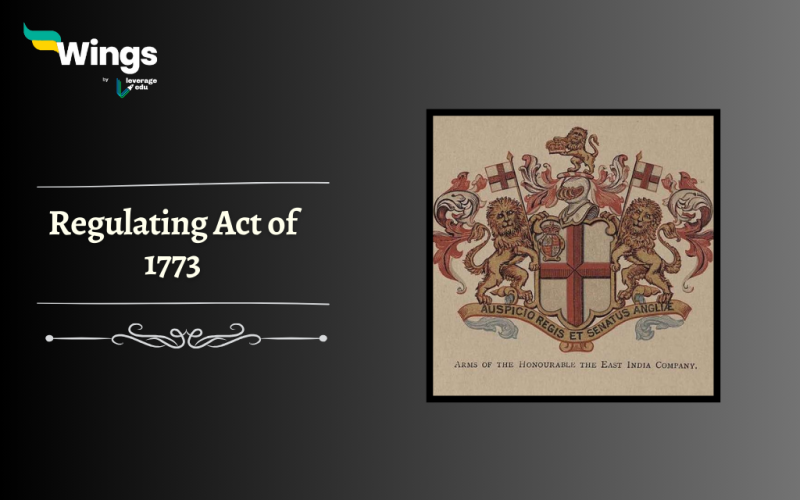The Regulating Act of 1773 was a significant moment in the history of colonial India’s governance. It marked the beginning of formal control of the British East India Company by the British government. This act was passed by the British Parliament and aimed to address the rampant corruption and mismanagement that was prevalent within the company as well as to establish a more regulated system of governance in India. In this article, we will delve into the background, features, and impact of the Regulating Act of 1773.
History of Regulating Act of 1773 (UPSC Notes)
The act was passed because of the various events that were continuously taking place due to the takeover of the East India Company over the Indian Subcontinent –
- The Growth of the British East India Company:
- The British East India Company was in financial trouble and asked for 1 million pounds as a loan from the British Government.
- By the mid-18th century, the company had become a major player in Indian trade and had gained considerable power and influence.
- The Bengal famine further added to the crisis and trouble in the Company.
- However, its dominance was marred by corruption, nepotism, and unchecked authority.
2. Battle of Plassey (1757):
- The Battle of Plassey wherein the British East India Company defeated the Nawab of Bengal marked a turning point in the company’s control over parts of India.
- It provided the company with substantial wealth and territorial claims.
3. The Dawn of British Government Intervention:
- The growing influence of the company raised concerns within the British government about the unchecked power wielded by the company in India.
- Numerous reports of corruption and exploitation further heightened the need for government intervention.
- The Company neglected the farmers and was concerned with generating revenues.
Also Read – The Government of India Act 1919
What were the Features of the Regulating Act of 1773?
Some of the features of the Regulating Act of 1773 are-
- Establishment of a Governor-General:
- The act created the position of Governor-General of Bengal, who would have supreme authority over all the company’s settlements in India.
- Warren Hastings became the first Governor-General under this act.
- The presidencies of Bombay and Madras were subsumed under the Bengal presidency.
- Formation of the Governor-General in Council:
- Alongside the Governor-General, a four-member council was established to assist in decision-making.
- The council had the power to veto the Governor-General’s decisions and act as a check on his authority.

- The Dual Control System:
- The act introduced a system of dual control with the British government having the power to regulate the company’s affairs in India.
- The Board of Control was formed to oversee the company’s operations and ensure accountability.
- Regulation of Company Employees:
- The act sought to address rampant corruption within the company by imposing regulations on its employees.
- It introduced a system of annual court hearings for the company’s officials making them accountable for their actions.
- A Supreme Court for Judiciary was also established at Calcutta where Sir Elijah Impey became the first Chief Justice.
Also Read – Government of India Act 1935: Key Features, Significance and More
Impact of the Regulating Act
The act laid the foundation for subsequent reforms in British India’s administrative structure. Some of the impacts and defects of the Act are-
- It established a centralised authority and brought about greater accountability among company officials. Even though corruption was still prevalent.
- The government gained greater control over the company’s affairs and its policies in India.
- Although, the Governor-General has no veto power in his hands.
- The act aimed to curb corruption, nepotism, and misuse of power within the company. It brought about greater oversight and regulation of the company’s operations, improving governance in India but failed due to vagueness in outlining the duties of the executive.
- The Regulating Act paved the way for subsequent acts and reforms, such as the Pitt’s India Act of 1784.
- It did not address the concerns of the farmers and tax-paying population.
In conclusion, the Regulating Act of 1773 was passed for the proper governance and administration of British India. It marked a turning point in the relationship between the British East India Company and the British government which led to increased oversight, regulation, and accountability. The act set the stage for further reforms in the following years laying the groundwork for British colonial rule in India.
Relevant Blogs
| Government of India Act 1858 | Charter Act 1833 |
| Indian Councils Act 1909 | Charles Wood’s Despatch |
| Charter Act 1813 | Charter Act 1853 |
| Complete List of Governor General of India | Full List Of Viceroys Of India |
That’s all about the Regulating Act of 1773! If you want to know more about topics like this, then visit our general knowledge page! Alternatively, you can also read our blog on general knowledge for competitive exams!
 One app for all your study abroad needs
One app for all your study abroad needs













